“Oh dear Lord, let me be born again in Banavasi, if not as a human then maybe as a honeybee. Let me over the flowery fields surrounding this beautiful land.” – Adikavi Pampa.
The Banavasi village is still a less explored place, the beauty of which has inspired the works of many ancient poets. A belief also persists that Mahakavi Kalidasa was inspired to create ‘Meghdoot’ by the beauty of Banavasi. Dramatically set around the Historic Madhukeshwara Temple, Banavasi looks like a movie set in the land where Varada River flows on both its sides.
The quiet and often misty lanes of Banavasi are flanked by old-styled and yet aesthetically neat houses. The ancient walled fort dating back to the 5th Century now lies in ruins veiled by bushes and trees. The town of Banavasi also finds its traces in the work of Claudius Ptolemy. (the one who created the first world map)
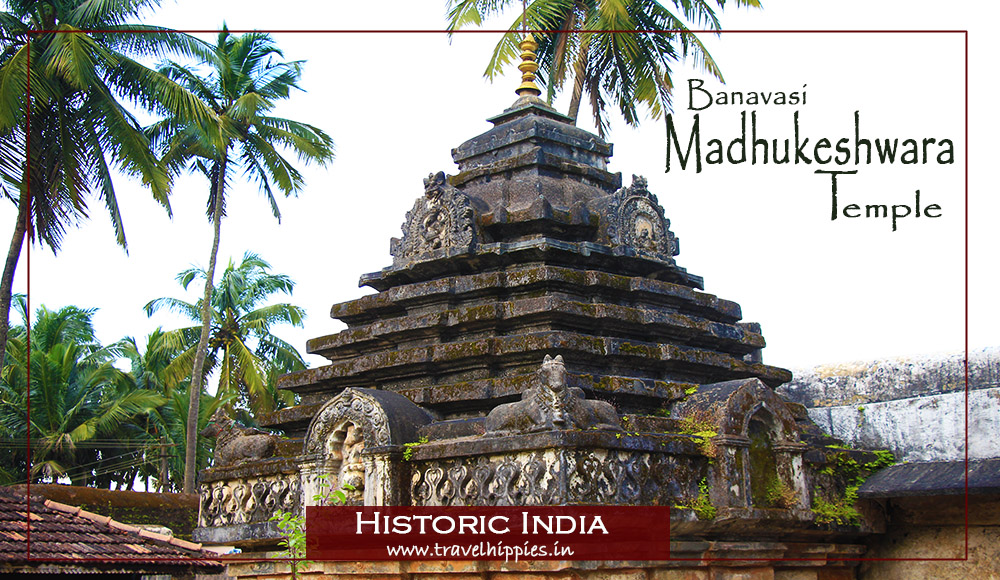
Before I go deeper into praising the beauty of this place, let’s see the exact location of Banavasi.
Where is Banavasi?
It is located around 387 kilometers northwest of Bangalore in the Karnataka state of India. It can be explored as a part of a day trip from Gokarna, Shimoga, Davangere, Hubli, Talguppa or Jog falls. The nearest popular town is Sirsi. The town of Banavasi falls in Sirsi Taluk which is at a distance of around 23 kilometers.

History of Banavasi
The oldest town in Karnataka is also its most ancient capital. Banavasi is supposed to have been the capital of the King Mayoora Sharma. He was a benevolent emperor of the Kuntala Kingdom of the Kadamba Dynasty. The then kingdom of Kunthala stretched till the islands of Mumbai in the North and Chikkamagaluru in the South. Over the centuries, Banavasi has earned different names for its beauty and changing cultures. As mentioned in the Sanskrit, Prakrit and Kannada inscriptions and scriptures, Banavasi was known as Vanavasika, Kaumudi, Baindivi, and Jayanthi. The elaborated epic of Mahabharata also mentions Banavasi as Sanjayanthipura which was ruled by Sahadeva, a Pandava.

The Kuntala Kingdom was a part of the Mahajanapadas, the early forms of democracies in ancient India. The 5th Century BC coins found during the excavation work in Banavasi is one of the oldest found in India.
Banavasi, as I personally felt, is more about exploring its rich nature, fertile lands, and preserved culture. We started our exploration with the famous Madhukeshwara Temple or Banavasi Temple, and so can you. This would apparently be one of the oldest temples of Karnataka having a 2nd Century idol.
Banavasi Madhukeshwara Temple History
The foundation of this Banavasi Temple is supposed to have been laid by King Mayoora Sharma. The architecture of the temple is now a mélange of Sonda, Hoysala, Chalukya, Pallava and Rashtrakuta schools that kept adding the structures until the 12th Century.
The main feature of this temple is that none of the deities are placed without their consorts and their vahana. (animal vehicles). The main mandapa of Madhukeshwara temple shares the compound with Devi Parvati on its right. The other special features of the Banavasi Madhukeshwara Temple include:
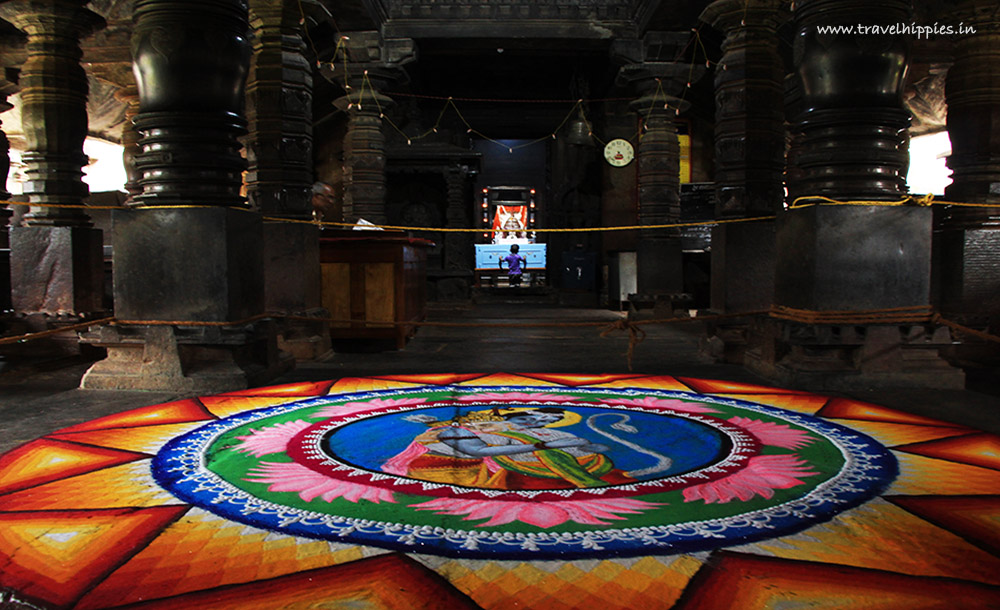
The Interior of the Main Temple
The entry to this ancient temple compound gives you a feeling of entering some museum of temples and idols. From ornately carved pillars to a simple-most sanctum sanctorum, each part of this temple is a reflection of the style of architecture followed by the kingdoms that ruled Banavasi and worshipped Madhukeshwara Linga.
- Dual Pillars: Unlike the other temples in South India, Madhukeshwara Temple has two pillars facing the mandapa of the main shrine. One of them is meant to light the lamps and is called Deepastambha. The other one is quite unusual with a stepped pyramidal base. A side of the steps also has an idol of Indra facing the garbhgriha of the main shrine of Madhukeshwara Mandir. The steps, just like the other walls of most temples are covered with the figures of a linga followed by Nandi.

- Basava/Nandi Mandapa: The ardhmandapa (porch) of the temple is followed by a 7 feet tall Nandi (bull) with a tilted head. One eye of the bull looks straight into the sanctum sanctorum at the Shivalinga. The other eye gives a diagonal Drishti (look) through the pillars to the adjacent temple of Adishakti or Parvati. The extensively carved Nandi is surrounded by carved granite pillars none of which are exactly similar.
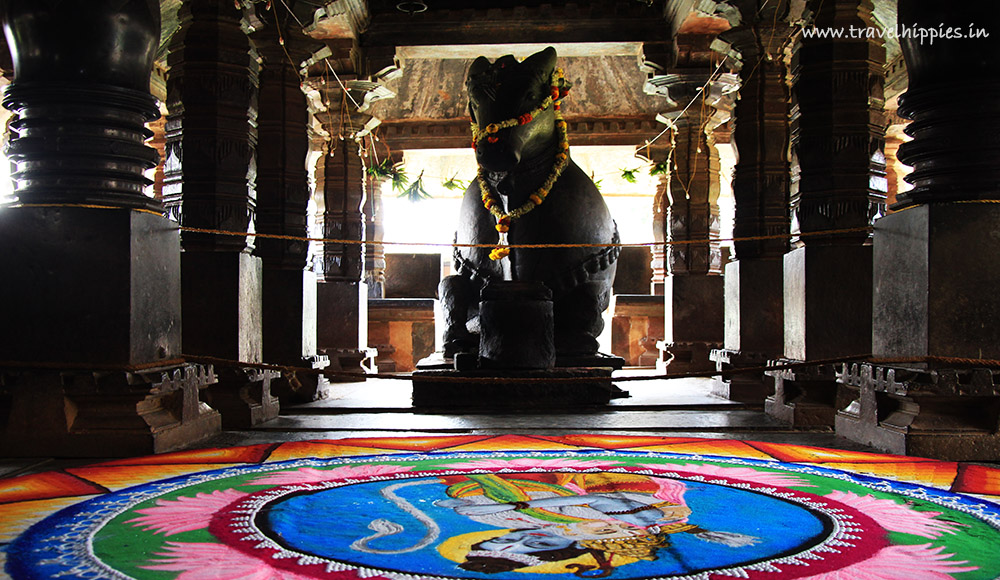
- Nritya Mantapa: This mandapa is a unique feature and evidence of the age-old Devadasi system. According to a Kannada folklore, a king tried to divert sage Allama from his asceticism by making a Devdasi (dancer) perform in front of him. The dancer named Maye tried her best to seduce Allama but in vain. This saint’s visit to this temple is quite important as he ended up being a guru to Basavanna. He turned out to be a social reformer who became the founder of the Lingayat community. Currently, Lingayat, a community of Shaivites, is an important caste in Karnataka. The architecture of the mandapa with a number of black stone pillars and benches can make you visualize some dancing scenes of the bygone era.
- Triloka Shrine or Shila Mantap: Before entering the Mahamandapa, a little mandap on the left of its entrance is bound to catch your attention. This intricately carved stone Mantapa is a representation of Triloka, the three worlds as per Hindu Mythology. The base is the Patal Lok netherworld (underworld) supported by a snake denoting its important part called ‘Nag Loka’. The middle part consists of the carved figures of various incarnations of Gods on earth. Lord Shiva and Parvati can be seen gracefully sitting on the Kailash Mountain. The shikhara of the mandap has lord Indra with his consort and other celestial dancers and devtas. This charming creation requires your time to admire and understand it. Do not miss out on the figures and carvings on its sides too.
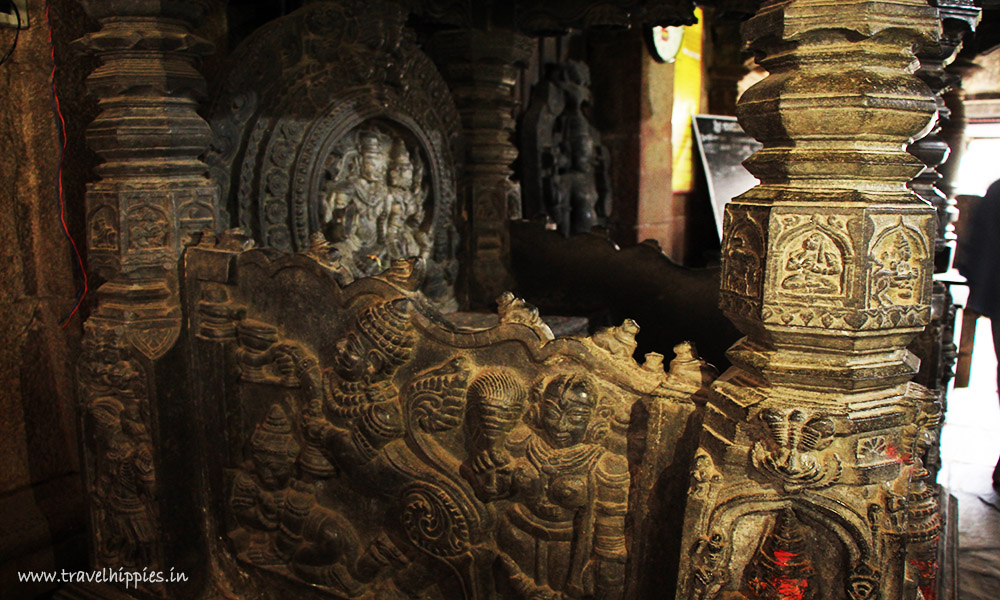
Triloka Mandap at Madhukeshwar Temple Banavasi

- Adimadhava-Madhusudan Avatara of Vishnu: As you enter the Darshana mandapa, a tall idol of Vishnu can be seen on your right. This uniquely carved idol of the deity is supposed to be the leading deity of the temple after whom it is named. Mythology suggests the manifestation of the Madhusudan avatar of Vishnu was witnessed here. And thus was laid the foundation of the temple. This idol is extremely artistic and the fine sculpting of it can leave you awestruck.
- The Madhu(Honey) Linga: The usual color of a linga is black and at some places, it’s a white marble stone. However, this 64 inches tall linga has a honey-colored stone. Honey is believed to a universal symbol of friendship owing to its sweet taste. Though this belief may be irrelevant in today’s world, the unique color of this shiva linga attracts thousands of travelers to this Banavasi Temple. The linga is covered with a silver face signifying a human form of the otherwise formless Madhukeshwara. The linga can be seen and touched only during the morning rituals.
- Parvati Temple: Goddess Parvati, who is the wife Shiva has her own identity. There are legends praising her shakti or ‘power’ which helped the Trilokas when all the other deities and Gods failed. Shakti followers have a separate sect in India and this temple welcomes both Shiva and Shakti devotees here. During the auspicious Navaratri days, the goddess is decorated in her different forms on each of the 10 days. When we visited, the goddess was in her Katyayini form. The mandapa was full of local ladies chanting the Katyayani Chalisa. This made the only non-commercial temple of south India more divine. The spiritual dose of this scene would leave your heart filled with contentment and your mind with peace.
Unknowingly, this temple erases the boundaries between the three main sects of the religion namely Shakti Upasaks, Shaivites and Vaishnavites.
If you are in love with such ancient architecture of temples then these are also for you
Shravanbelagola – Unravel the Real Story of The Mighty Bahubali
The Deities on the Wall of the Main Shrine
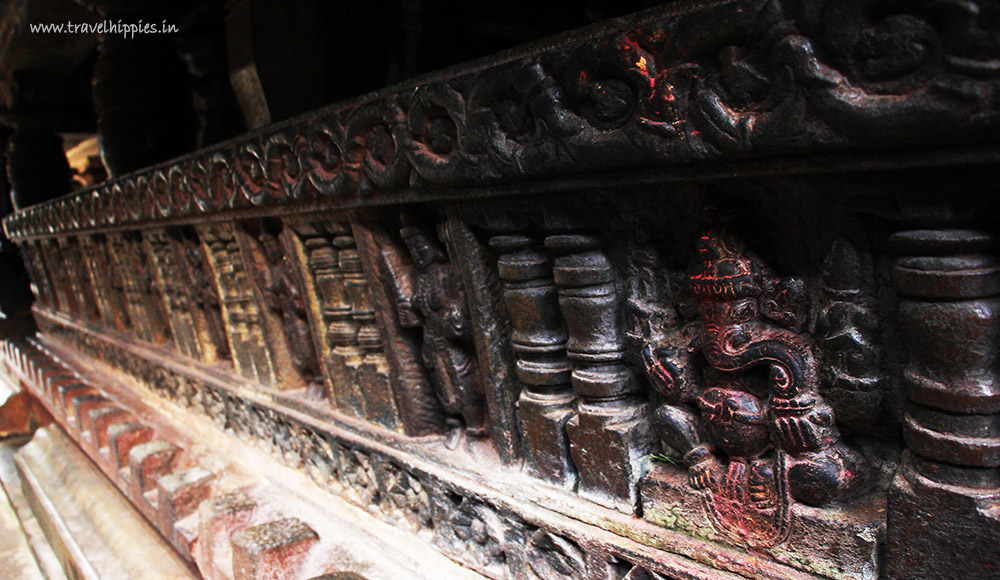
Most of the shrines in this temple complex have their walls depicting the scene of the sanctum sanctorum of the Madhukeshwara shrine. That is, a shiva linga faced by a Nandi. On the other hand, the mandapa walls of the main shrine can visually be identified as a late construction. They have an intricately carved out series of different deities venerated in this region. It also includes the dashavtar of Lord Vishnu and certain kinds of Lord Ganesh.
The Temple Courtyard of the Madhukeshwara Temple

- The entrance and the Annadanam Hall: A wide lane bordered by old-fashioned houses leads to the east-facing entrance of Madhukeshwara Temple. The gopuram or the gate is much damaged but the twin elephants on each side welcome the devotees to a huge compound of the temple complex.
- Museum of Excavated Artifacts and Inscription: The excavation project of ASI has led to some very important discoveries about Banavasi. Along the left side of the entrance is a small area wherein the artifacts and inscriptions have been displayed for the public. Though you can’t enter inside, you can have a look from the barred railings.
- Stone Cot or Raghunatha Cot: This brilliant stone creation is made up of 10 stones joined together to make a bed. King Raghunatha gifted it to the temple. Since then, it is used during the Kadambotsva and other festivals in Banavasi. The idols are carried or displayed on this beautifully carved cot. The ceiling of the cot has a design of a lotus whereas the pillars have various mythological animals carved out of them.
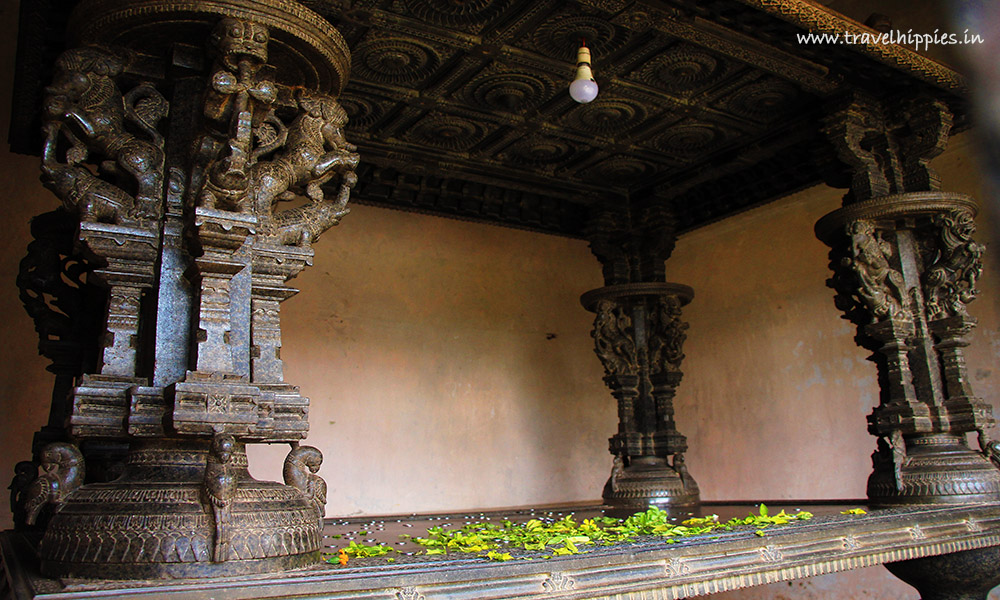
- Devtas and Their Consorts: This unusual idea of placing the devtas along with their consorts and vehicles make this temple one of its kind. Moreover, they are also facing a certain direction following the concept of cosmology in Hinduism. There is Indra with Airavat (an elephant), Lord Angi with a goat, Lord Kubera with Nar, Yama riding on his buffalo, Varuna with a crocodile, Vayu with a spotted deer and so on. You can stroll around and can improve your knowledge about the devtas and their vahana. Recognizing them in each of the small temples around the complex. Start from the Stone cot and move clockwise.
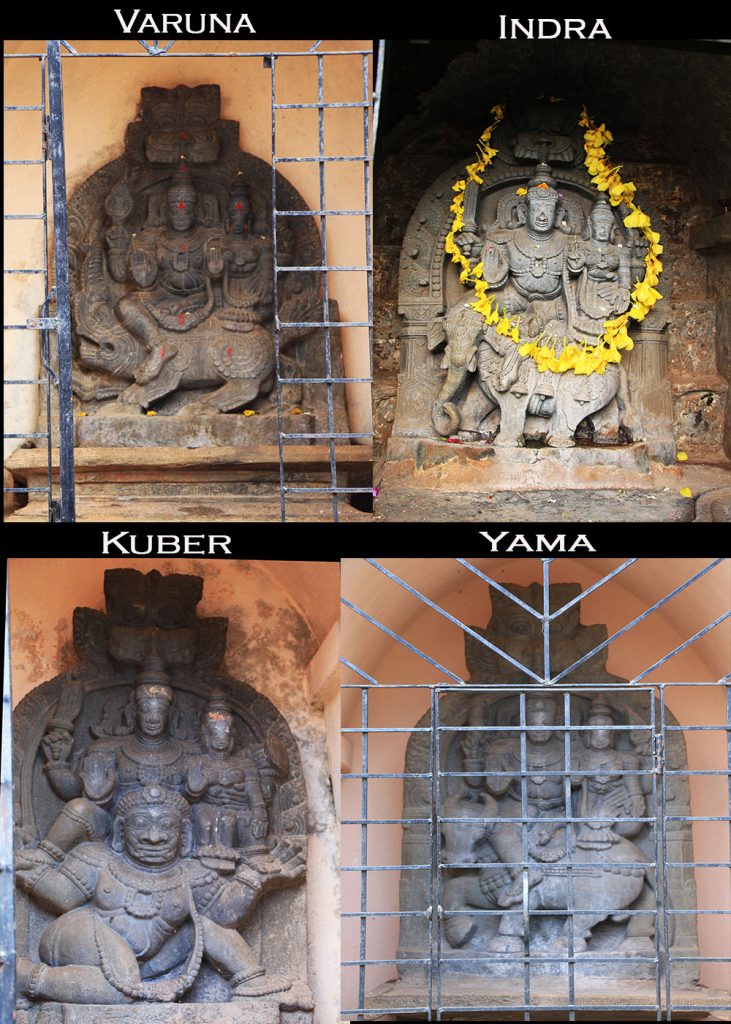
- Mahanaga from the 2nd Century: Among all the temples around the complex there a sculpture of a tactfully designed Naga coiled in the shape of horizontal eights. The five hoods resemble more to the petals of a shoe flower. This is supposed to have been gifted by Sivaskanda Nagashri as per the Prakrit inscriptions below the stone. It is believed that the kingdom of Kadamba was also called Nagarakhanda for a brief period and Kadambas, the nagas. There are strange historic shifts in the identity of this place as per the researches by historians.
- Narsimha and Krishna Temples: On each side of the main two shrines are the temples of Krishna and Narsimha, the avatars of Vishnu. There are hardly any idols or carvings in these temples. However, some incomplete carving on the walls of the Krishna temple is quite intriguing.
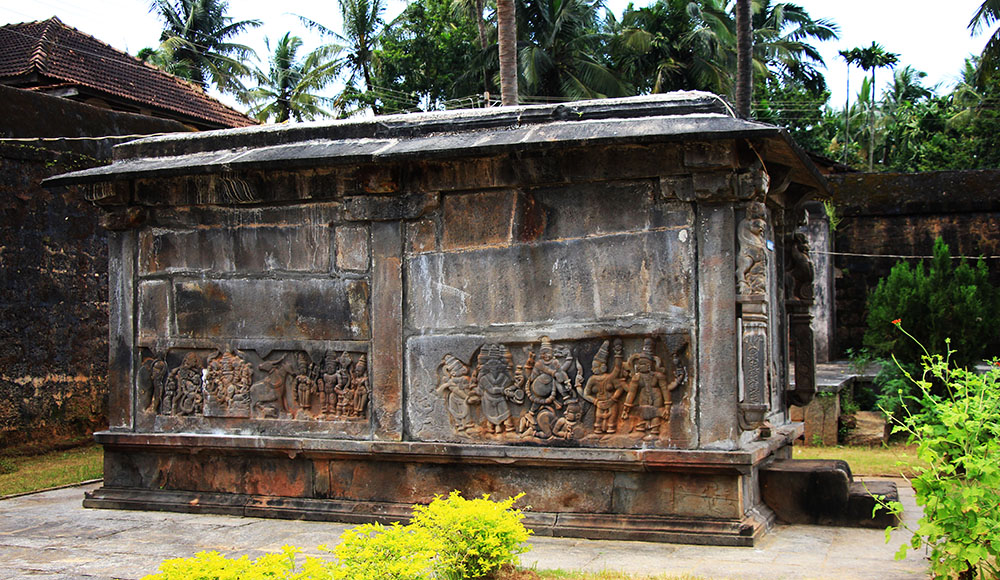
- Lingas and Idols from Around the Country: The kings of the Kadamba and the following dynasties made this temple complex a pilgrim by placing an idol or linga brought from every important pilgrim in India. There are lingas from Rameshwaram, Varanasi, Kedarnath, and Amruteshwara. Other idols include Ayodhya Rama, Vittala from Pandhripur in Maharashtra, Venkateshwara from Tirupati, Sun God from Konark and Chintamani Ganesha. In a way, visiting this temple is like visiting all the important pilgrims of India.
Other Places to Visit in Banavasi
Pampavana
Adikavi Pampa lived and created a few of his best works from this little forest where once existed his hut. His work is considered one of the ‘Three Gems of Kannada Literature’. ‘Pampa, Ponna, Ranna’ are the three celebrated poets of Karnataka who are also called the three gems. This tiny forest is permanently closed for the visitors but you can have its glimpse from outside.
Gudnapura Lake

At a distance of around 5 kilometers, surrounded by green fields and a view of the Malenadu hills is this sunset point of Banavasi. Sunset, seen from anywhere on the outskirts of Banavasi looks immensely vibrant. However, post-monsoon this lake is a must-visit. Bird lovers may also spot or hear some local birds of the region.
Farms and Fields
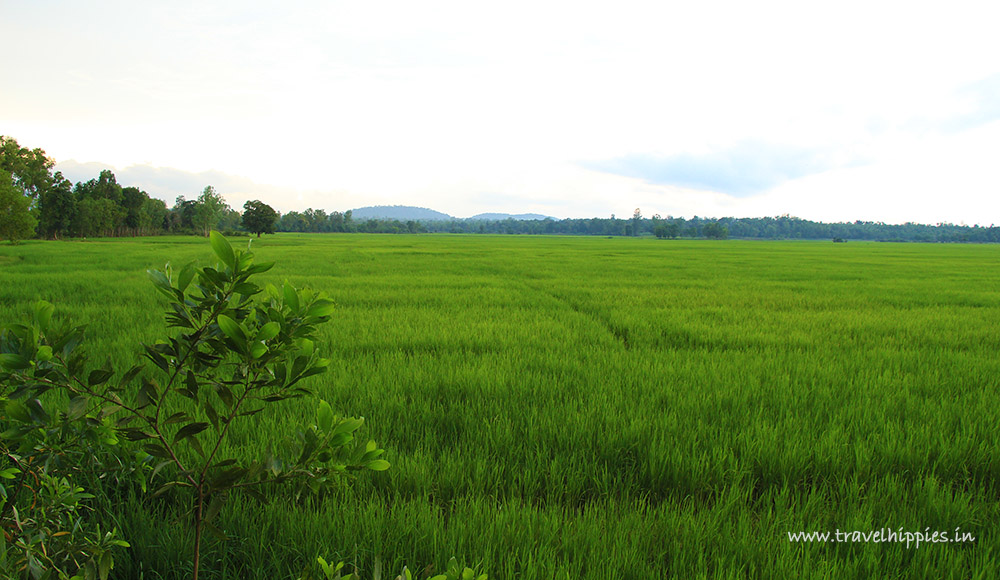
Pineapple farms and factories are favorite among the travelers in Banavasi. Sometimes, the local ladies in Banvasi also organize a feast serving different varieties of dishes using pineapple. Tall trees of areca nuts, coconut, and other spices make the interior routes picturesque.
Route from Banavasi to Siddapur

One of the most gorgeous roads from Banavasi leads to Siddapur. We had taken a night halt at Siddapur while heading to our next destination, Jog Falls. Initially, we were a bit skeptical about this highway suggested by google as it is a single lane road. Our doubt was soon subdued as we drove on the road in fairly good condition. Throughout our drive, there were scenic farms plowed by bullocks and the dramatic clouds just added to the feel. If you are on a road trip and driving anywhere to or from Jog Falls, you must take this route starting from Pampavana.
Cultural Extravaganza of Banavasi
The oldest capital of Karnataka is still one of the more preferred options to catch a live performance of Yakshgana. This traditional dance form of Karnataka is vibrant and lively if you can manage to understand Kannada. You may also stumble upon many artisans in the market specialized in making Yakshgana masks.
How to Reach Banavasi
- By Tain: The nearest station is Talguppa. It is connected to most major cities of Karnataka namely, Bangalore, Mysore, Hubli, and Shimoga. Talguppa Express runs daily from Mysore via Bangalore, Shimoga.
- By Bus: KSRTC buses run till Sirsi. More information can be found on their official website.
- By Road: It can be a beautiful road trip from Bangalore or Mysore via Chikkamaglure- Shimoga –Siddapur- Sirsi route. We covered Banavasi as a part of a road trip from Bangalore to Jog Falls via the Udupi-Gokarna-Yana route. Udupi and Gokarna both turned out to be a rejuvenating experience.You can get a glimpse of the complete route and details here.
Read about the must-do things in Udupi and Gokarna here. things
Where to Stay in Banavasi
Uttara Karnataka Tourism department has built a tourist lodge called Vanvasika. It serves a beautiful view on the outskirts of Banavasi near the Varada River. You can either opt for a night stay here or can head towards Jog Falls and stay at Ibbani Homestay in Siddapur. It is a little cosy home amidst the misty farms of Siddapur and is only a 15km away from Jog Falls.
Further readings
The Better India – Photo Story
Are you fascinated by such historic temples? Would you like to visit it on any of your trips? Let me know in the comment below.
Found it useful? Pin it now
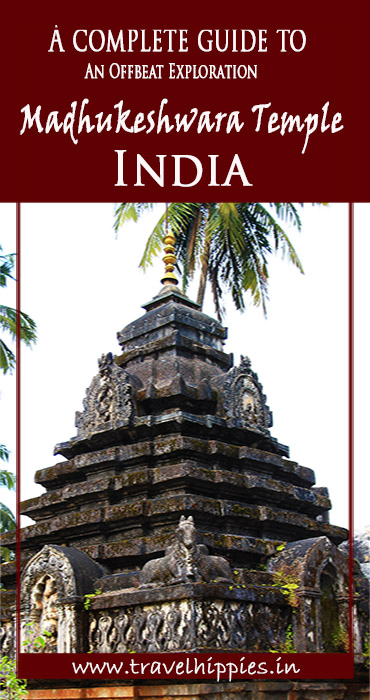
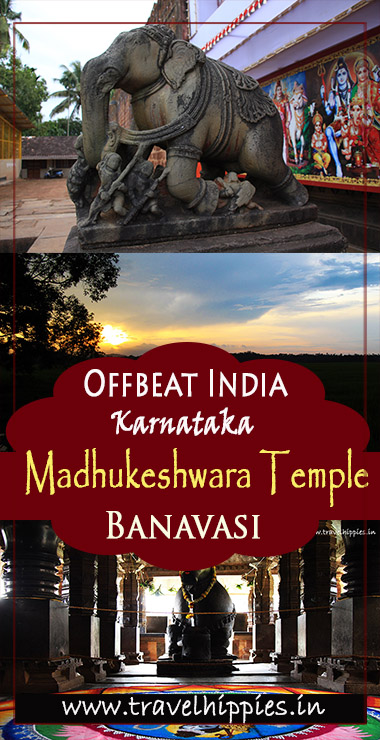
Follow me on
